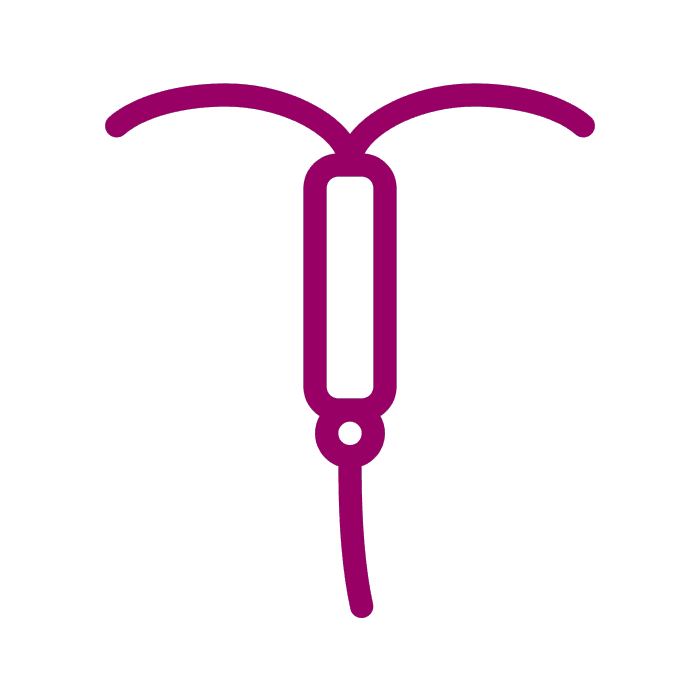
MALE CONDOM
Barrier Method
A condom is a thin film sheath that is placed over a man’s erect penis before having sex.
82 % Effective
Details
Condoms are sometimes called a “barrier” method of contraception. They are made of very thin latex (rubber) or similar material. They prevent pregnancy by stopping sperm from meeting an egg. Condoms are the only type of contraception that can prevent pregnancy and protect against sexually transmitted illnesses (STIs) if used correctly. To be effective, male condoms have to be used every time you have sex. When used correctly, male condoms are 98% effective against pregnancy.
Some people are allergic to latex, in which case using polyurethane or polyisoprene condoms may help prevent an allergic reaction.
How to
Using a condom can be an enjoyable part of sex and does not have to feel like an interruption. To use it, gently roll the condom down to the base of the erect penis. After sex, take out the penis while it is still erect, making sure to hold the condom on at the base of the penis while you do this, and be careful not to spill any semen. Remove the condom from the penis and throw it away. If you have sex again, use a new condom.
Do not use oil-based lubricants – such as lotion, body oil or petroleum jelly if you are using latex condoms. These can damage the condom and may cause it to split.
Pros
Can be used on demand and are readily available
If used correctly, they are 98% effective against pregnancy
Protect against STIs if used correctly during vaginal, anal and oral sex.
They are available in a variety of shapes, sizes and flavours.
Cons
Can interrupt sex
Can tear or come off during sex if not used correctly
Some people are allergic to latex
Side Effects
There are none, although some people may be allergic to latex
Frequently Asked Questions
-
A condom is a thin film sheath placed over a man’s erect penis before sex.
-
There is a range of tests performed by both regulatory agencies and condom manufacturers. These include electronic testing, the water leak test, the air burst test and the strength test.
-
There is a range of tests performed by both regulatory agencies and condom manufacturers. These include electronic testing, the water leak test, the air burst test and the strength test.
-
Check that the use-by date has not expired, that they carry a standards approval mark (either FDA, ISO, CE or the British Standard Kite Mark), and that they have been properly stored.
-
As with most barrier methods, it can take a bit of practice to use this method correctly. As long as you are clear on how to use them, you should get the hang of it.
-
Compared to modern hormonal methods, condoms are less reliable and effective in protecting against pregnancy but they are the only method that will protect against STIs, including HIV/AIDS.















CONTRACEPTIVE METHODS
CONTRACEPTIVE METHODS
-

CONTRACEPTIVE IMPLANT
1 or 2 small hormone-releasing silicone rods placed under the skin by a healthcare provider.
-

CONTRACEPTIVE INJECTION
The contraceptive injection is a shot of hormones that lasts for 1 up to 3 months.
-

CONTRACEPTIVE PATCH
A patch that sticks to the skin and releases hormones that are highly effective at stopping pregnancy.
-

CONTRACEPTIVE RING
A flexible plastic ring that is placed in the vagina by the woman and constantly releases hormones.
-

DIAPHRAGM
A diaphragm is a small dome that blocks the entrance to the cervix to stop sperm from entering the womb.
-

EMERGENCY CONTRACEPTIVES
Emergency contraceptives are hormone-based pills that are used in the event of accidental unprotected sex.
-

FEMALE CONDOM
A female condom is a sheath that is placed inside a woman’s vagina before sexual intercourse.
-

FERTILITY AWARENESS
Fertility awareness is the method of only having sex on the non-fertile days of your menstrual cycle.
-

INTRAUTERINE DEVICE
An IUD is a small, flexible, often T-shaped device wrapped in copper that is placed inside your womb by your healthcare provider.
-

INTRAUTERINE SYSTEM-IUS
An IUS is a small, flexible, T-shaped system that releases low levels of hormones and is placed inside the womb by your healthcare provider.
-

PULL-OUT METHOD
Pulling out (also called Withdrawal Method) requires no additional hormones or devices, just impeccable timing and a lot of luck.
-

SPERMICIDES
Spermicides affect the way sperm travels in the womb making it hard for them to move freely and fertilize an egg.
-

SPONGE
A sponge blocks the entrance to the cervix and releases spermicide, both together stopping sperm from entering the womb and fertilizing an egg.
-

STERILISATION
Sterilisation is the process of completely taking away the body’s ability to reproduce through surgery or minimal invasion.
-

THE PILL
The pill is a small tablet containing hormones that must be swallowed every day, at the same time.



